The Effects of Allium sativum L., Artemisia absinthium L., Cucurbita pepo L., Coriandrum sativum L., Satureja hortensis L. and Calendula officinalis L. on the Embryogenesis of Ascaris suum Eggs during an In Vitro Experimental Study
Abstract
1. Introduction
2. Results
2.1. Analysis of Plant Extracts
2.2. Analysis of Plant Extracts Activity
3. Discussion
4. Materials and Methods
4.1. Preparation of A. suum Eggs Stock Solution
4.2. Obtainment of Alcoholic Plant Extracts
4.3. Experimental Design
4.4. Eggs Hatch Test/Larval Development Assay
4.5. Statistical Analysis and Ontologies/Pathogens, Diseases, Medicinal Plants and Chemical Compounds
5. Conclusions
Supplementary Materials
Author Contributions
Funding
Institutional Review Board Statement
Informed Consent Statement
Data Availability Statement
Acknowledgments
Conflicts of Interest
References
- Sytar, O.; Švedienė, J.; Ložienė, K.; Paškevičius, A.; Kosyan, A.; Taran, N. Antifungal properties of hypericin, hypericin tetrasulphonic acid and fagopyrin on pathogenic fungi and spoilage yeasts. Pharm. Biol. 2016, 54, 3121–3125. [Google Scholar] [CrossRef] [PubMed]
- Ložienė, K.; Švedienė, J.; Paškevičius, A.; Raudonienė, V.; Sytar, O.; Kosyan, A. Influence of plant origin natural α-pinene with different enantiomeric composition on bacteria, yeasts and fungi. Fitoterapia 2018, 127, 20–24. [Google Scholar] [CrossRef] [PubMed]
- Magryś, A.; Olender, A.; Tchórzewska, D. Antibacterial properties of Allium sativum L. against the most emerging multidrug-resistant bacteria and its synergy with antibiotics. Arch. Microbiol. 2021, 203, 2257–2268. [Google Scholar] [CrossRef] [PubMed]
- Bin, C.; Al-Dhabi, N.A.; Esmail, G.A.; Arokiyaraj, S.; Arasu, M.V. Potential effect of Allium sativum bulb for the treatment of biofilm forming clinical pathogens recovered from periodontal and dental caries. Saudi J. Biol. Sci. 2020, 27, 1428–1434. [Google Scholar] [CrossRef]
- Doligalska, M.; Jóźwicka, K.; Szewczak, L.; Nowakowska, J.; Brodaczewska, K.; Goździk, K.; Szakiel, A. Calendula officinalis Triterpenoid Saponins Impact the Immune Recognition of Proteins in Parasitic Nematodes. Pathogens 2021, 10, 296. [Google Scholar] [CrossRef]
- Thamsborg, S.M.; Nejsum, P.; Mejer, H. Impact of Ascaris suum in livestock. In Ascaris: The Neglected Parasite; Holland, C., Ed.; Elsevier: Amesterdam, The Netherlands, 2013; pp. 363–381. [Google Scholar]
- Kim, M.K.; Pyo, K.H.; Hwang, Y.S.; Park, K.H.; Hwang, I.G.; Chai, J.Y.; Shin, E.H. Effect of temperature on embryonation of Ascaris suum eggs in an environmental chamber. Korean J. Parasitol. 2012, 50, 239–242. [Google Scholar] [CrossRef]
- Oh, K.S.; Kim, G.T.; Ahn, K.S.; Shin, S.S. Effects of disinfectants on larval development of Ascaris suum eggs. Korean J. Parasitol. 2016, 54, 103–107. [Google Scholar] [CrossRef][Green Version]
- Hossain, M.S.; Dey, A.R.; Alim, M.A.; Begum, N. In vitro efficacy of medicinal plant material on the inhibition of development of egg of Ascaridia galli. Adv. Parasitol. 2015, 2, 5–10. [Google Scholar] [CrossRef]
- Urban, J.; Kokoska, L.; Langrova, I.; Matejkova, J. In vitro anthelmintic effects of medicinal plants used in Czech Republic. Pharm. Biol. 2008, 46, 808–813. [Google Scholar] [CrossRef]
- Jafari, F.; Ghavidel, F.; Zarshenas, M.M. A critical overview on the pharmacological and clinical aspects of popular Satureja species. J. Acupunct. Meridian Stud. 2016, 9, 118–127. [Google Scholar] [CrossRef]
- Aćimović, M.G.; Kostadinović, L.M.; Puvača, N.M.; Popović, S.J.; Urošević, M.I. Phytochemical constituents of selected plants from Apiaceae family and their biological effects in poultry. Food Feed Res. 2016, 43, 35–41. [Google Scholar] [CrossRef]
- Beigh, Y.A.; Ganai, A.M. Potential of wormwood (Artemisia absinthium Linn.) herb for use as additive in livestock feeding: A review. Pharma Innov. 2017, 6, 176. [Google Scholar]
- Ratnam, N.; Naijibullah, M.; Ibrahim, M.D. A review on Cucurbita pepo. Int. J. Pharmacogn. Phytochem. Res. 2017, 9, 1190–1194. [Google Scholar] [CrossRef]
- Ahmed, E.H.; Abadi, R.S.; Mohammed, A.M. Phytochemical screening, chemical composition and antioxidant activity of seeds essential oil of Coriandrum sativum L. from the Sudan. Int. J. Herb. 2018, 6, 1–4. [Google Scholar]
- Baskaran, K.; Marigold, C.; Marigold, G.; English, P.M.; German, B. Pharmacological activities of Calendula officinalis. Int. J. Sci. Res. 2017, 6, 43–47. [Google Scholar]
- El-Saber Batiha, G.; Magdy Beshbishy, A.; Wasef, L.G.; Elewa, Y.H.; Al-Sagan, A.A.; El-Hack, A.; Prasad Devkota, H. Chemical constituents and pharmacological activities of garlic (Allium sativum L.): A review. Nutrients 2020, 12, 872. [Google Scholar] [CrossRef]
- Szopa, A.; Pajor, J.; Klin, P.; Rzepiela, A.; Elansary, H.O.; Al-Mana, F.A.; Ekiert, H. Artemisia absinthium L.—Importance in the history of medicine, the latest advances in phytochemistry and therapeutical, cosmetological and culinary uses. Plants 2020, 9, 1063. [Google Scholar] [CrossRef]
- Hussein, S.N.; Shukur, M.S. In vitro anthelmintic efficacy of pumpkin seed oil (Cucurbita pepo) on toxocariosis (Toxocara cati). Explor. Anim. Med. Res. 2020, 10, 154–161. [Google Scholar]
- Dhingra, G.; Dhakad, P.; Tanwar, S. Review on phytochemical constituents and pharmacological activities of plant Calendula officinalis Linn. Biology 2022, 2, 216–228. [Google Scholar] [CrossRef]
- Yuniarti, I.; Yunus, M.; Utama, S.; Koesdarto, S.; Suwanti, L.T.; Widjaja, N.M.R. Effect of garlic (Allium sativum) infusion on the time of death of Ascaridia galli. J. Parasite Sci. 2017, 1, 43–46. [Google Scholar] [CrossRef]
- Kaplan, R.M.; Vidyashankar, A.N. An inconvenient truth: Global worming and anthelmintic resistance. Vet. Parasitol. 2012, 186, 70–78. [Google Scholar] [CrossRef] [PubMed]
- Shalaby, H.A. Anthelmintics resistance; how to overcome it? Iran. J. Parasitol. 2013, 8, 18–32. [Google Scholar] [PubMed]
- Dibfiora, R.; Situmorang, E.U.; Firmansyah, R.D. Efficacy of Shallot (Allium cepa L. Var. aggregatum) and Garlic (Allium sativum) as Herbal Anthelmintic against Ascaris suum. J. Med. Health 2021, 3, 34–45. [Google Scholar] [CrossRef]
- Orengo, K.O.; Maitho, T.; Mbaria, J.M.; Maingi, N.; Kitaa, J.M. In vitro anthelmintic activity of Allium sativum, Allium cepa and Jatropha curcas against Toxocara canis and Ancylostoma caninum. Afr. J. Pharm. Pharmacol. 2016, 10, 465–471. [Google Scholar] [CrossRef]
- Raza, A.; Muhammad, F.; Bashir, S.; Aslam, B.; Anwar, M.I.; Naseer, M.U. In vitro and in vivo anthelmintic potential of different medicinal plants against Ascaridia galli infection in poultry birds. Worlds Poult. Sci. J. 2016, 72, 115–124. [Google Scholar] [CrossRef]
- Kanojiya, D.; Shanker, D.; Sudan, V.; Jaiswal, A.K.; Parashar, R. Assessment of in vitro and in vivo anthelminthic potential of extracts of Allium sativum bulb against naturally occurring ovine gastrointestinal nematodiosis. Vet. Q. 2015, 35, 200–206. [Google Scholar] [CrossRef]
- Khalil, A.I.; Radwan, N.A.; Osman, G.Y.; Abo Msalam, A.M.; Maghrabi, O.A. In vitro effect of LC90 of albendazole and Allium sativum water extract on the fine structure of Capillaria sp. (Capillaridae Nematoda). J. Biosci. Appl. Res. 2016, 2, 125–135. [Google Scholar] [CrossRef]
- Goud, B.J.; Swamy, B.C. A review on history, controversy, traditional use, ethnobotany, phytochemistry and pharmacology of Artemisia absinthium Linn. Int. J. Adv. Res. Eng. Appl. Sci. 2015, 4, 77–107. [Google Scholar]
- Yıldız, K.; Başalan, M.; Duru, Ö.; Gökpınar, S. Antiparasitic efficiency of Artemisia absinthium on Toxocara cati in naturally infected cats. Turkiye Parazitol. Derg. 2011, 35, 10–14. [Google Scholar] [CrossRef]
- Tariq, K.A.; Chishti, M.Z.; Ahmad, F.; Shawl, A.S. Anthelmintic activity of extracts of Artemisia absinthium against ovine nematodes. Vet. Parasitol. 2009, 160, 83–88. [Google Scholar] [CrossRef]
- Caner, A.; Döşkaya, M.; Değirmenci, A.; Can, H.; Baykan, Ş.; Üner, A.; Gürüz, Y. Comparison of the effects of Artemisia vulgaris and Artemisia absinthium growing in western Anatolia against trichinellosis (Trichinella spiralis) in rats. Exp. Parasitol. 2008, 119, 173–179. [Google Scholar] [CrossRef] [PubMed]
- Seidavi, A.; Tavakoli, M.; Slozhenkina, M.; Gorlov, I.; Hashem, N.M.; Asroosh, F.; Swelum, A.A. The use of some plant-derived products as effective alternatives to antibiotic growth promoters in organic poultry production: A review. Environ. Sci. Pollut. Res. 2021, 28, 47856–47868. [Google Scholar] [CrossRef] [PubMed]
- Ahmed, W.M. The potential effect of Allium sativum and Coriandrum sativum as natural sources of antioxidants on Haemonchus contortus infection in sheep. J. Egypt Soc. Parasitol. 2019, 15, 89–113. [Google Scholar] [CrossRef][Green Version]
- Eguale, T.; Tilahun, G.; Debella, A.; Feleke, A.; Makonnen, E. In vitro and in vivo anthelmintic activity of crude extracts of Coriandrum sativum against Haemonchus contortus. J. Ethnopharmacol. 2007, 110, 428–433. [Google Scholar] [CrossRef]
- Macedo, I.T.F.; Oliveira, L.M.B.D.; Camurça-Vasconcelos, A.L.F.; Ribeiro, W.L.C.; Santos, J.M.L.D.; Morais, S.M.D.; Bevilaqua, C.M.L. In vitro effects of Coriandrum sativum, Tagetes minuta, Alpinia zerumbet and Lantana camara essential oils on Haemonchus contortus. Rev. Bras. Parasitol. Vet. 2013, 22, 463–469. [Google Scholar] [CrossRef] [PubMed]
- Al-Snafi, A.E. Antiparasitic, antiprotozoal, molluscicidal and insecticidal activity of medicinal plants (part 2)—Plant-based review. Sch. Acad. J. Pharm. 2016, 5, 194–207. [Google Scholar] [CrossRef]
- Helal, M.A.; Abdel-Gawad, A.M.; Kandil, O.M.; Khalifa, M.M.; Cave, G.W.; Morrison, A.A.; Elsheikha, H.M. Nematocidal effects of a coriander essential oil and five pure principles on the infective larvae of major ovine gastrointestinal nematodes in vitro. Pathogens 2020, 9, 740. [Google Scholar] [CrossRef]
- Hosseinzadeh, S.; Ghalesefidi, M.J.; Azami, M.; Mohaghegh, M.A.; Hejazi, S.H.; Ghomashlooyan, M. In vitro and in vivo anthelmintic activity of seed extract of Coriandrum sativum compared to Niclosamid against Hymenolepis nana infection. J. Parasit. Dis. 2016, 40, 1307–1310. [Google Scholar] [CrossRef]
- Boros, Z.; Baies, M.H.; Gherman, C.; Cozma, V. The effects of Artemisia absinthium (wormwood), Allium sativum (garlic), Cucurbita pepo (pumpkin), and Coriandrum sativum (coriander) on Trichinella spiralis and Trichinella britovi larvae, in vitro study. Sci. Parasitol. 2021, 22, 70–78. [Google Scholar]
- Hellawi, H.; Ibrahim, O.M. Evaluation of Anthelmintic Activity of N-hexane Extract of Cucurbita maxima and Azadirachta indica Pulp Seed Against Ascaridia galli in vitro. Biochem. Cell. Arch. 2021, 21, 211–217. [Google Scholar]
- Aziz, A.R.A.; Aboulaila, M.R.; Aziz, M.; Omar, M.A.; Sultan, K. In vitro and in vivo anthelmintic activity of pumpkin seeds and pomegranate peels extracts against Ascaridia galli. Beni-Suef Univ. J. Basic Appl. Aci. 2018, 7, 231–234. [Google Scholar]
- Ganestya, S.; Djumarca, S.; Utari, C.S. Anthelmintic effects of pumpkin (Cucurbita moschata) seed extract on Ascaris suum in vitro. J. Asian Nat. Prod. Res. 2012, 10, 1–6. [Google Scholar] [CrossRef][Green Version]
- Fierascu, I.; Dinu-Pirvu, C.E.; Fierascu, R.C.; Velescu, B.S.; Anuta, V.; Ortan, A.; Jinga, V. Phytochemical profile and biological activities of Satureja hortensis L.: A review of the last decade. Molecules 2018, 23, 2458. [Google Scholar] [CrossRef] [PubMed]
- Moazeni, M.; Saharkhiz, M.J.; Alavi, A.M. The lethal effect of a nano emulsion of Satureja hortensis essential oil on protoscoleces and germinal layer of hydatid cysts. Iran. J. Parasitol. 2019, 14, 214–222. [Google Scholar] [CrossRef] [PubMed]
- Urban, J.; Tauchen, J.; Langrova, I.; Kokoska, L. In vitro motility inhibition effect of Czech medicinal plant extracts on Chabertia ovina adults. J. Anim. Plant Sci. 2014, 21, 3293–3302. [Google Scholar]
- Štrbac, F.; Bosco, A.; Amadesi, A.; Rinaldi, L.; Stojanović, D.; Simin, N.; Ratajac, R. Ovicidal Potential of Five Different Essential Oils to Control Gastrointestinal Nematodes of Sheep. Pak. Vet. J. 2020, 41, 353–358. [Google Scholar]
- Štrbac, F.; Bosco, A.; Maurelli, M.P.; Ratajac, R.; Stojanović, D.; Simin, N.; Rinaldi, L. Anthelmintic properties of essential oils to control gastrointestinal nematodes in sheep—In vitro and in vivo studies. Vet. Sci. 2022, 9, 93. [Google Scholar] [CrossRef]
- Cernea, M.; Cernea, L.C.; Răileanu, Ş.; Năstasa, V.; Mareş, M.; Ognean, L.; De Carvalho, L.M.M. The efficacy of herbal extract on equine Strongylidosis. Sci. Pap. J. 2010, 53, 575–581. [Google Scholar]
- Ashwlayanvd, K.A.; Verma, M. Therapeutic potential of Calendula officinalis. Pharm. Pharmacol. Int. 2018, 6, 149–155. [Google Scholar]
- Boyko, O.; Brygadyrenko, V. Nematicidal activity of essential oils of medicinal plants. Folia Oecol. 2021, 48, 42–48. [Google Scholar] [CrossRef]
- Doligalska, M.; Jóźwicka, K.; Kiersnowska, M.; Mroczek, A.; Pączkowski, C.; Janiszowska, W. Triterpenoid saponins affect the function of P-glycoprotein and reduce the survival of the free-living stages of Heligmosomoides bakeri. Vet. Parasitol. 2011, 179, 144–151. [Google Scholar] [CrossRef] [PubMed]
- Anusuya, N.; Durgadevi, P.; Dhinek, A.; Mythily, S. Nephroprotective effect of ethanolic extract of garlic (Allium sativum L.) on cisplatin induced nephrotoxicity in male wistar rats. Asian J. Pharm. Clin. Res. 2013, 6, 97–100. [Google Scholar]
- Ursache, A.L.; Mircean, V.; Dumitrache, M.; Andrei, S.; Ştefănuţ, L.; Cozma, V.; Cernea, M. Is routine disinfection efficient in preventing contamination with Toxocara canis eggs? J. Helminthol. 2020, 94, e60. [Google Scholar] [CrossRef]
- Dmitryjuk, M.; Szczotko, M.; Kubiak, K.; Trojanowicz, R.; Parashchyn, Z.; Khomitska, H.; Lubenets, V. S-methyl-(2-methoxycarbonylamino-benzimidazole-5) thiosulfonate as a potential antiparasitic agent—its action on the development of Ascaris suum eggs in vitro. Pharmaceuticals 2020, 13, 332. [Google Scholar] [CrossRef]
- Mircean, V.; Cozma, V.; Gyorke, A. Diagnostic Coproscopic în Bolile Parazitare la Animale (Coproparasitological Diagnostic in Parasitic Diseases in Animals); Risoprint: Cluj-Napoca, Romania, 2011; pp. 23–35. [Google Scholar]
- Rusu, M.E.; Gheldiu, A.M.; Mocan, A.; Moldovan, C.; Popa, D.S.; Tomuta, I.; Vlase, L. Process optimization for improved phenolic compounds recovery from walnut (Juglans regia L.) septum: Phytochemical profile and biological activities. Molecules 2018, 23, 2814. [Google Scholar] [CrossRef]
- Rusu, M.E.; Fizeșan, I.; Pop, A.; Gheldiu, A.M.; Mocan, A.; Crișan, G.; Tomuta, I. Enhanced recovery of antioxidant compounds from hazelnut (Corylus avellana L.) involucre based on extraction optimization: Phytochemical profile and biological activities. Antioxidants 2019, 8, 460. [Google Scholar] [CrossRef] [PubMed]
- Benedec, D.; Hanganu, D.; Filip, L.; Oniga, I.; Tiperciuc, B.; Olah, N.K.; Vlase, L. Chemical, antioxidant and antibacterial studies of Romanian Heracleum sphondylium. Farmacia 2017, 65, 252–256. [Google Scholar]
- Mocan, A.; Vlase, L.; Vodnar, D.C.; Gheldiu, A.M.; Oprean, R.; Crișan, G. Antioxidant, antimicrobial effects and phenolic profile of Lycium barbarum L. flowers. Molecules 2015, 20, 15060–15071. [Google Scholar] [CrossRef]
- Rusu, M.E.; Fizesan, I.; Pop, A.; Mocan, A.; Gheldiu, A.M.; Babota, M.; Popa, D.S. Walnut (Juglans regia L.) Septum: Assessment of bioactive molecules and in vitro biological effects. Molecules 2020, 25, 2187. [Google Scholar] [CrossRef]
- Toiu, A.; Mocan, A.; Vlase, L.; Pârvu, A.E.; Vodnar, D.C.; Gheldiu, A.M.; Oniga, I. Comparative phytochemical profile, antioxidant, antimicrobial and in vivo anti-inflammatory activity of different extracts of traditionally used Romanian Ajuga genevensis L. and A. reptans L. (Lamiaceae). Molecules 2019, 24, 1597. [Google Scholar] [CrossRef]
- Ielciu, I.; Hanganu, D.; Ramona, P.; Vlase, L.; Frederich, M.; Gheldiu, A.M.; Crișan, G. Antioxidant capacity and polyphenolic content of the Echinocystis lobata (Michx.) Torr. et A. Gray flowers. Pak. J. Pharm. Sci. 2018, 31, 677–683. [Google Scholar]
- Vlase, L.; Parvu, M.; Parvu, E.A.; Toiu, A. Chemical constituents of three Allium species from Romania. Molecules 2012, 18, 114–127. [Google Scholar] [CrossRef] [PubMed]
- Ivanescu, B.; Miron, A.; Corciova, A. Sesquiterpene lactones from Artemisia genus: Biological activities and methods of analysis. J. Anal. Methods Chem. 2015, 2015, 247685. [Google Scholar] [CrossRef] [PubMed]
- Ivanescu, B.; Lungu, C.; Vlase, L.; Gheldiu, A.M.; Grigorescu, C.; Corciova, A. Bioactive compounds from Artemisia campestris L. subsp. Campestris. Rev. Chim. 2018, 69, 3076–3081. [Google Scholar] [CrossRef]
- Buza, V.; Cătană, L.; Andrei, S.M.; Ștefănuț, L.C.; Răileanu, Ș.; Matei, M.C.; Cernea, M. In vitro anthelmintic activity assessment of six medicinal plant aqueous extracts against donkey strongyles. J. Helminthol. 2020, 94, e147. [Google Scholar] [CrossRef]
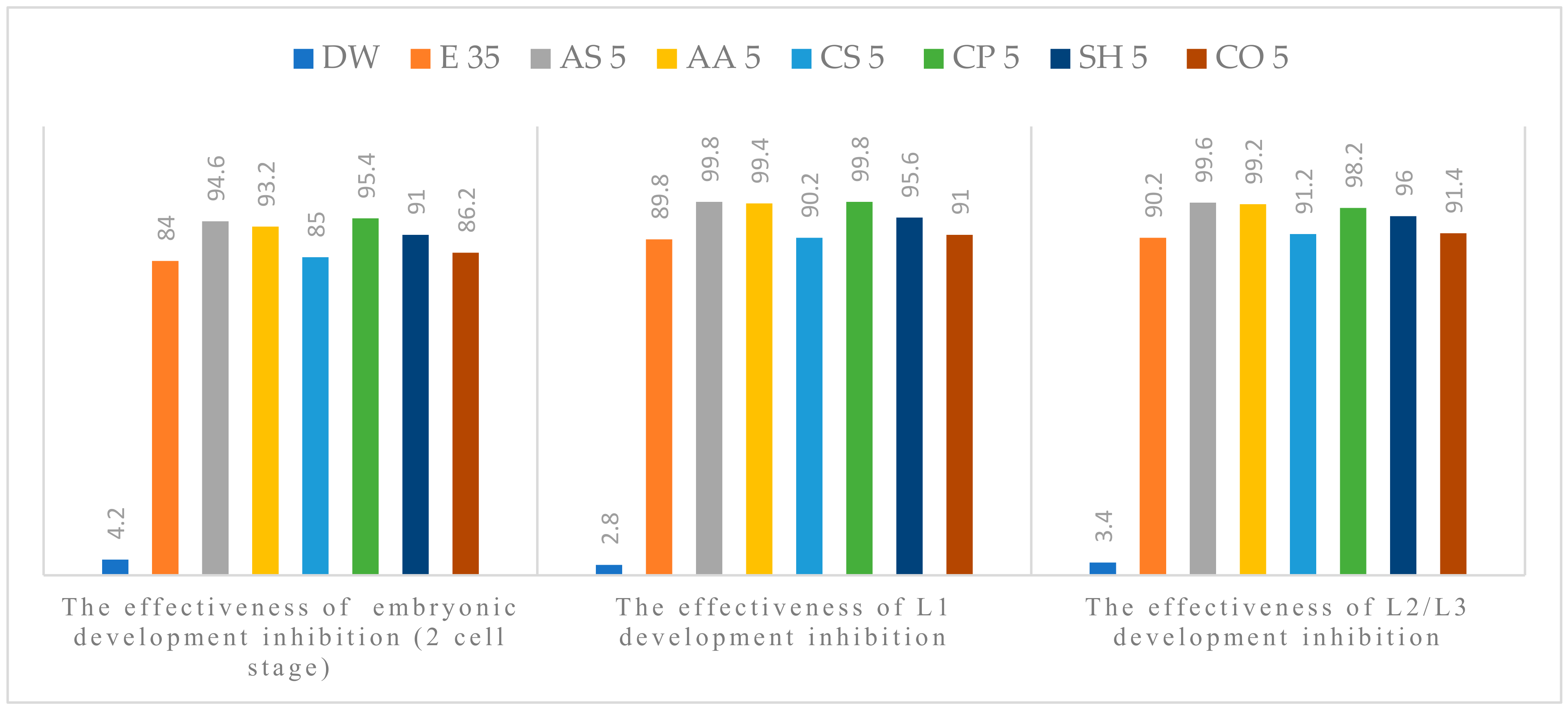
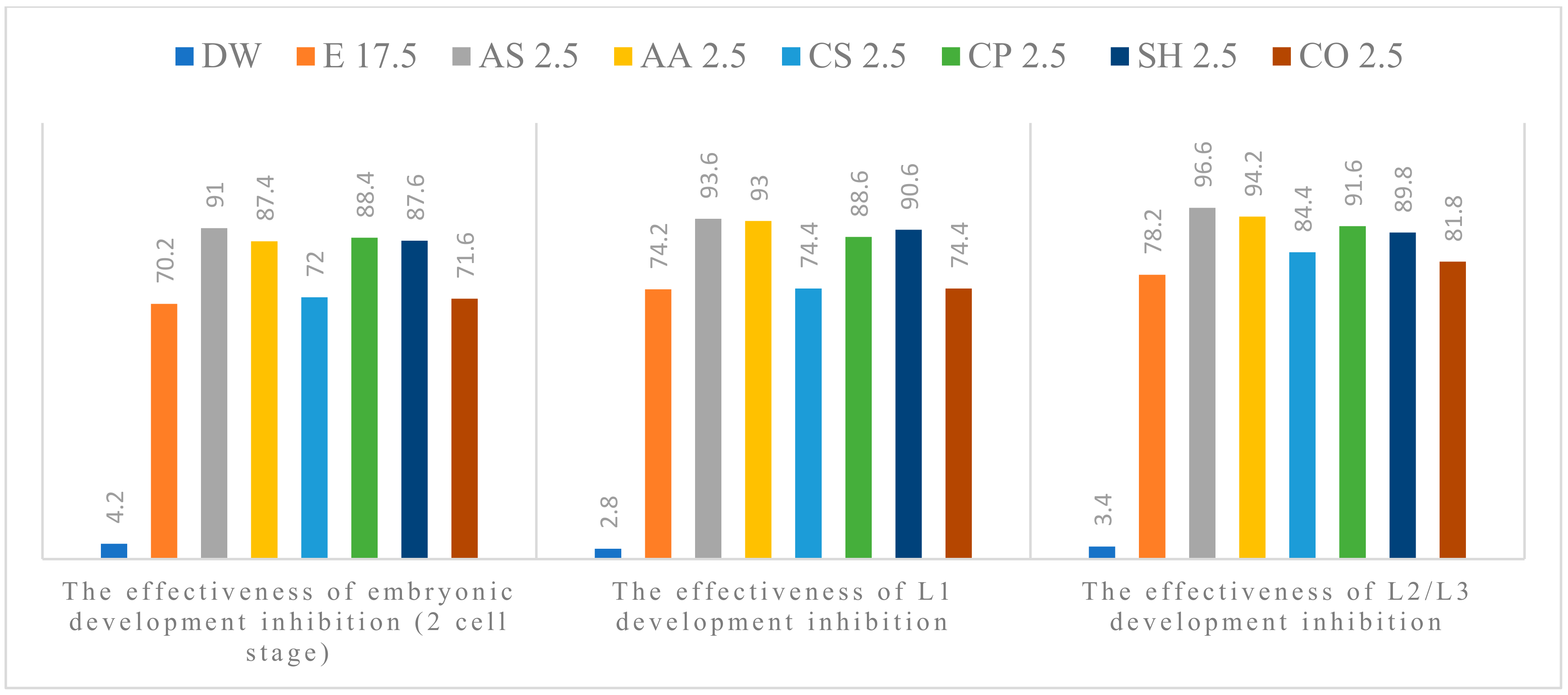
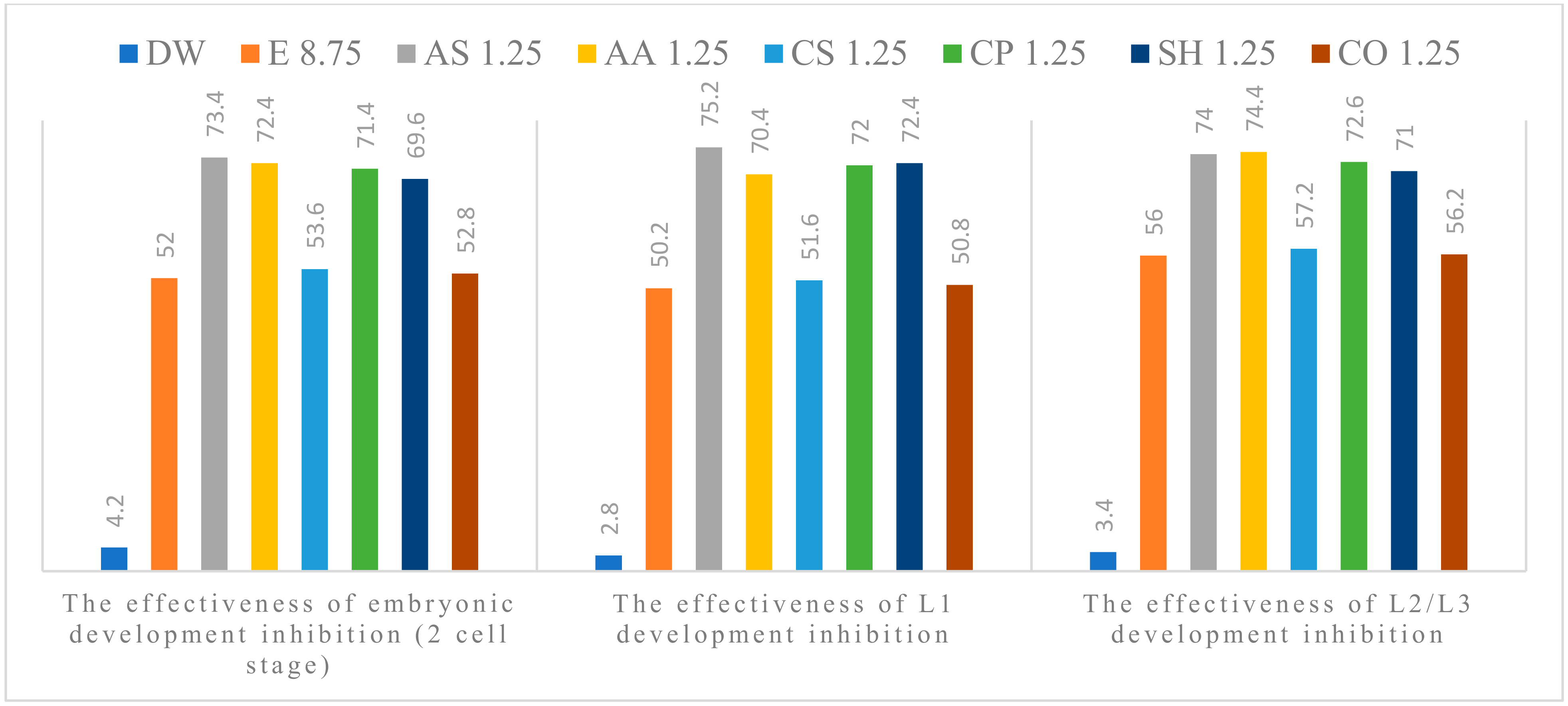
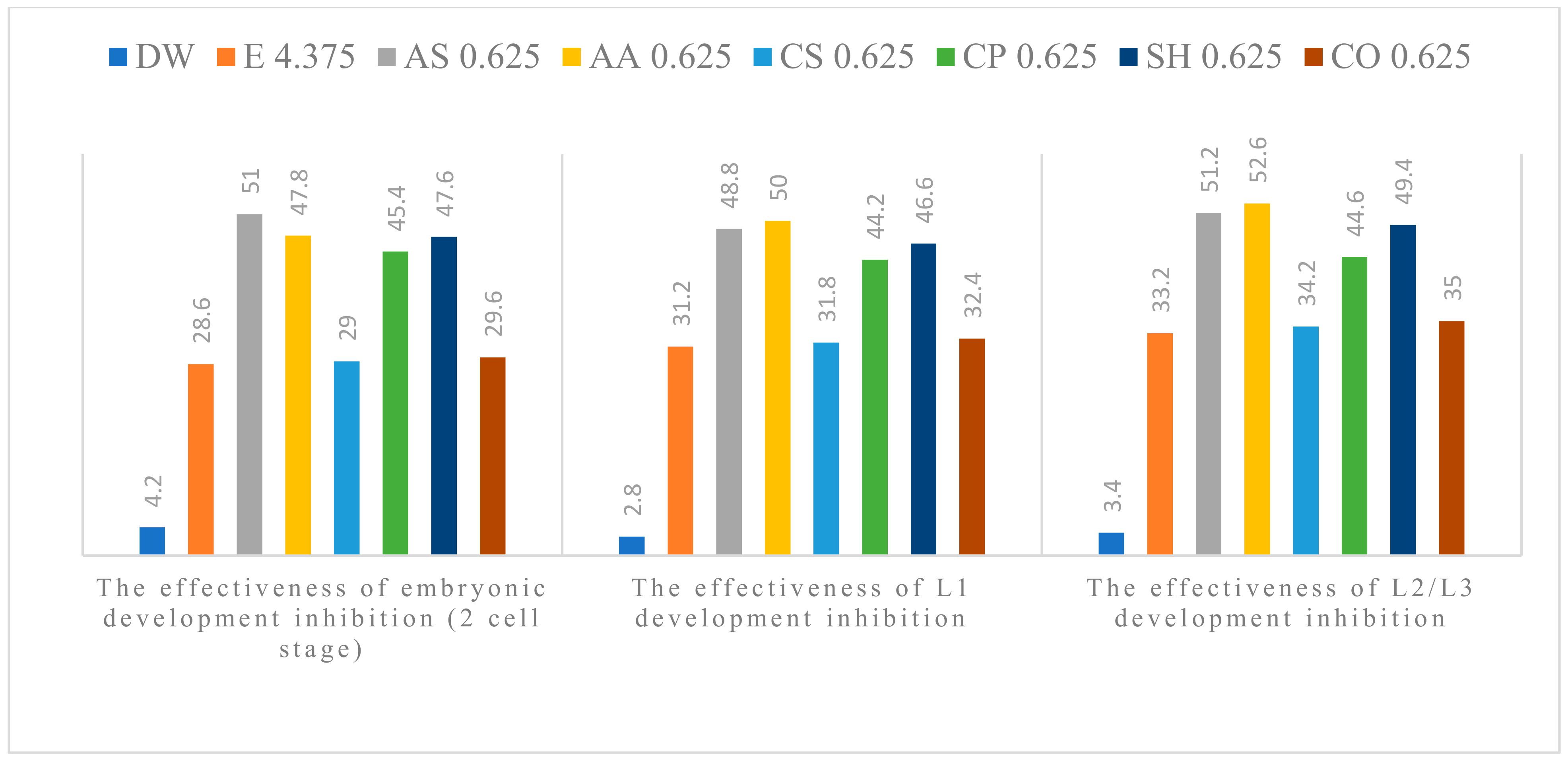
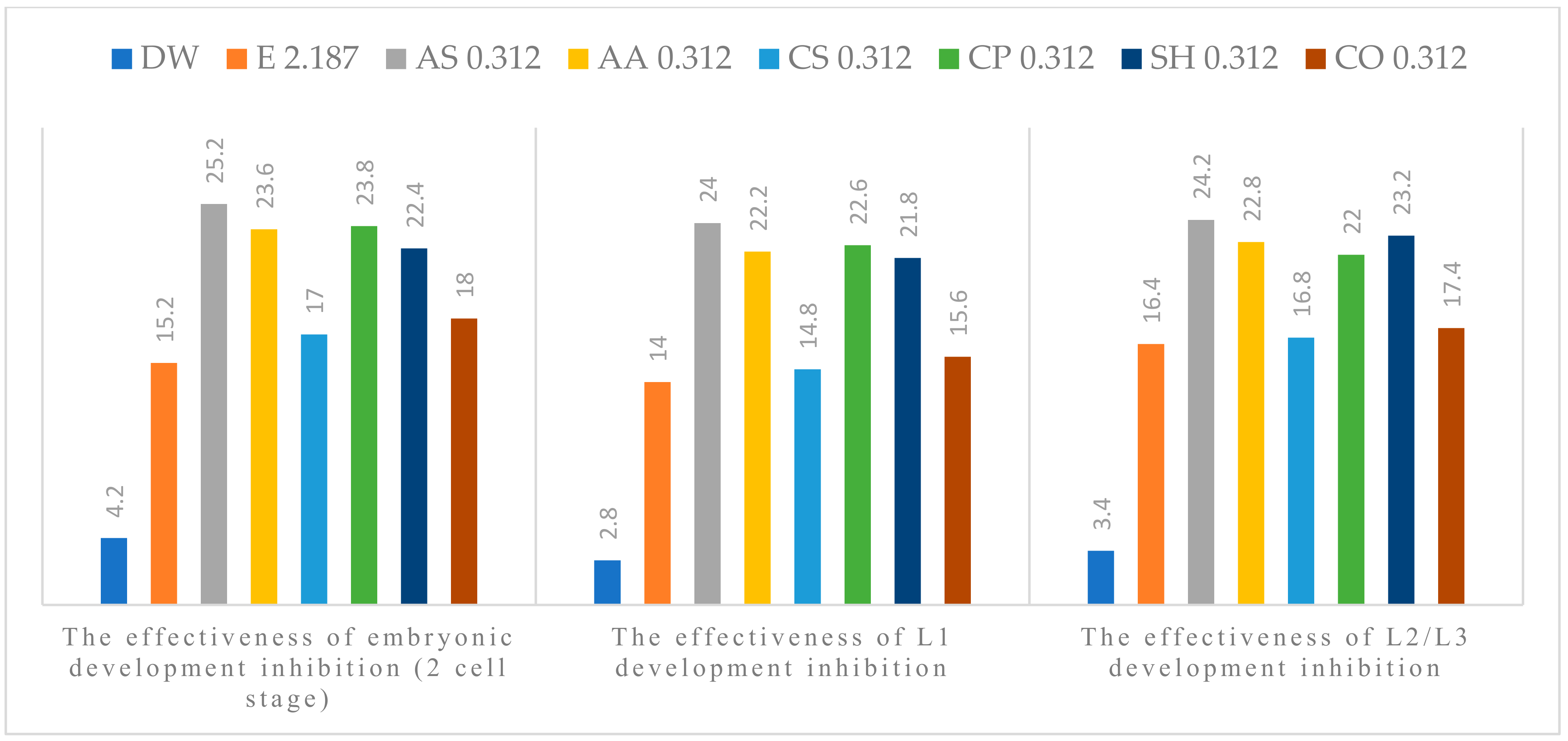
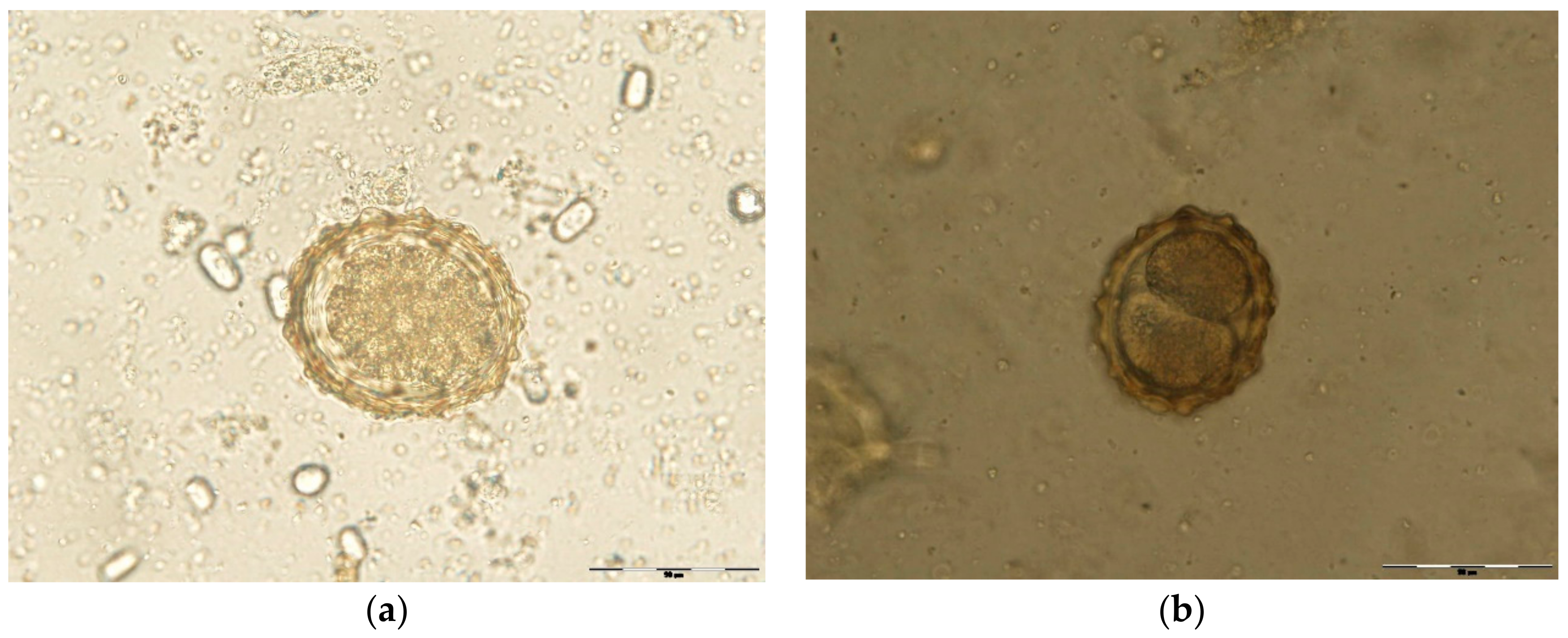
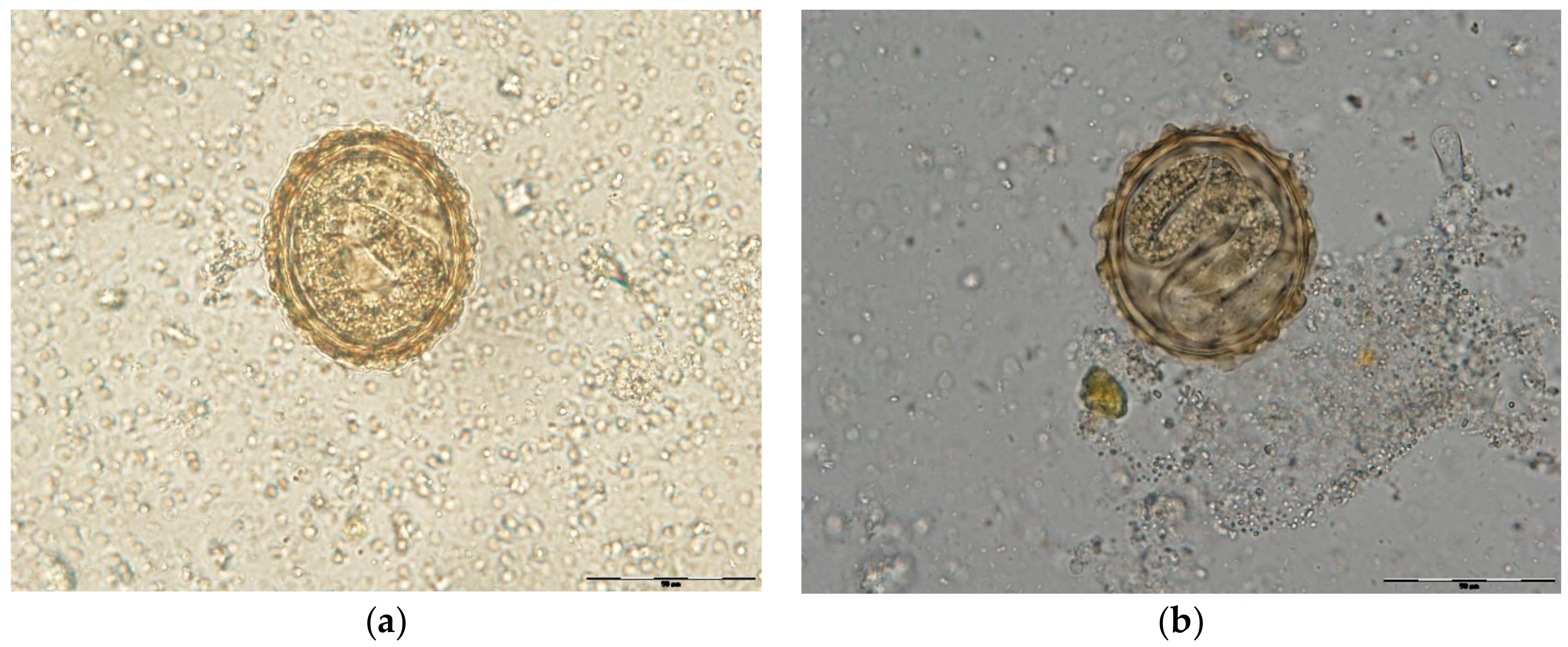
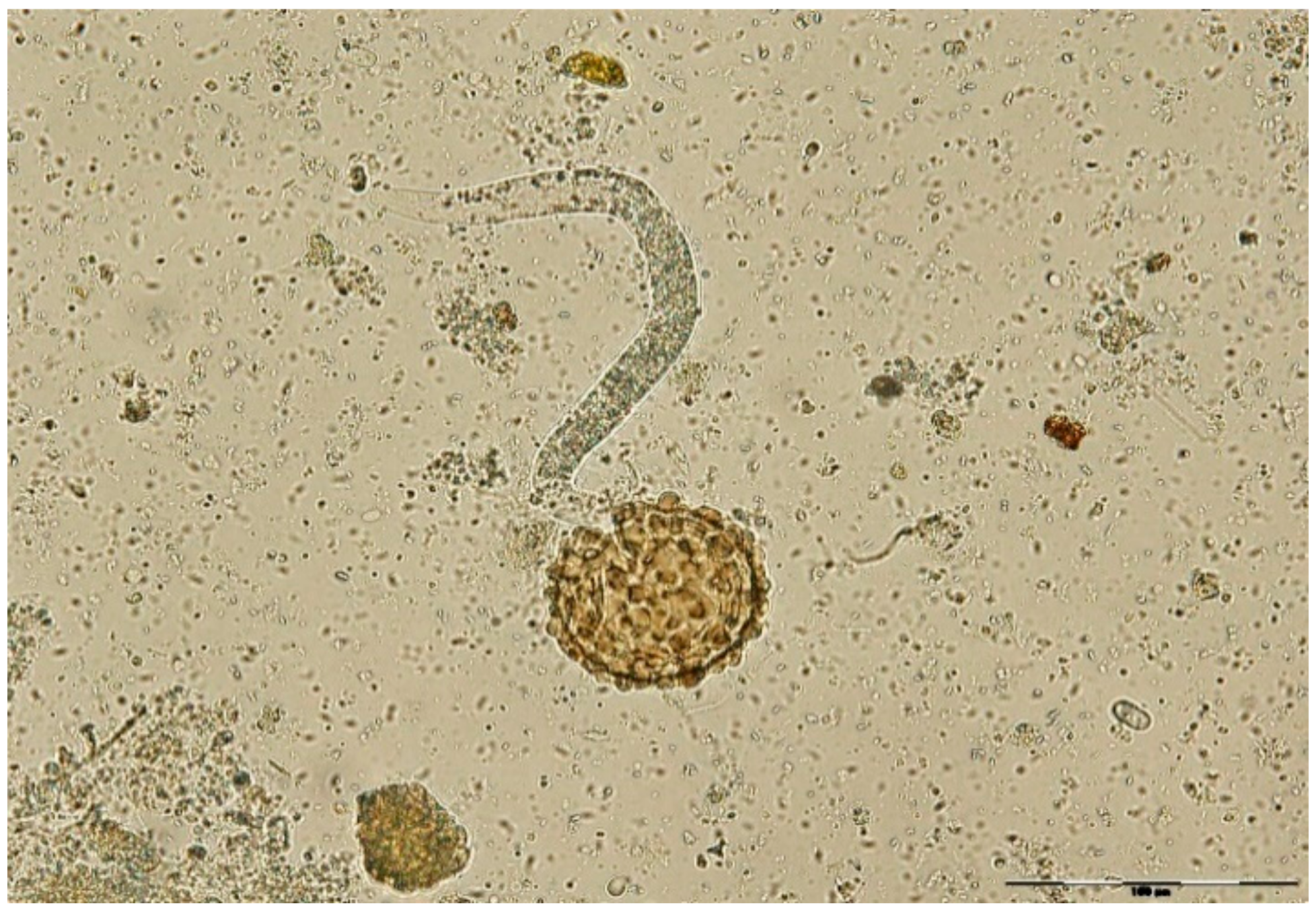
| Bioactive Compounds | Vegetal Species and Plant Part Used for Extraction and LC-MS Analysis | ||||||
|---|---|---|---|---|---|---|---|
| Artemisia absinthium L. | Satureja hortensis L. | Calendula officinalis L. | Allium sativum L. | Coriandrum sativum L. | Cucurbita pepo L. | ||
| herba | herba | herba | bulbus | fructus | semen | ||
| Polyphenols (μg/mL) | Chlorogenic acid | 107.15 | <LOQ | 220.767 | - | 4.177 | - |
| Caffeic acid | - | <LOQ | - | 1.221 | - | - | |
| p-coumaric acid | 0.621 | 1.464 | - | - | 0.501 | - | |
| Ferulic acid | 0.759 | 0.557 | - | 0.456 | 0.759 | - | |
| Sinapic acid | - | - | - | 0.228 | - | - | |
| Vitexin | 1.631 | - | - | - | - | - | |
| Isoquercitrin | 56.754 | 6.515 | 38.877 | - | - | - | |
| Rutoside | 3.826 | <LOQ | 18.819 | - | <LOQ | - | |
| Quercitrin | 1.113 | 0.365 | <LOQ | - | - | - | |
| Quercetol | 6.285 | 0.394 | - | - | - | - | |
| Luteolin | 1.159 | 6.621 | - | - | - | - | |
| Kaempferol | 3.666 | - | - | - | - | - | |
| Apigenin | 0.481 | 2.442 | - | - | - | - | |
| Syringic acid | 1.85 | 2.28 | 1.51 | - | 0.09 | - | |
| Protocatechuic acid | 1.32 | 0.95 | 0.67 | - | - | - | |
| Vanillic acid | 1.98 | 0.65 | 0.44 | - | 0.94 | - | |
| Tocopherols (ng/mL) | α-tocopherol | 50.0 | 86.8 | 61.6 | 36.1 | - | - |
| γ-tocopherol | 23.8 | 89.0 | 248.9 | - | - | 446.0 | |
| Δ-tocopherol | 5.0 | 13.2 | 9.3 | - | - | 23.2 | |
| Sterols (μg/mL) | Ergosterol | 0.344 | 1.420 | 0.500 | - | 0.584 | - |
| Stigmasterol | 34.831 | 14.215 | 72.888 | - | 9.675 | 22.024 | |
| Β-sitosterol | 140.985 | 313.315 | 241.997 | - | 31.548 | 5.355 | |
| Campesterol | 3.329 | 6.140 | 1.635 | - | 1.780 | 0.358 | |
| Methoxylated flavones (ng/mL) | Jaceosidin | - | 8820.76 | - | - | - | - |
| Hispidulin | 3047.92 | 2483.00 | - | - | - | - | |
| Eupatorin | 976.53 | - | - | - | - | - | |
| Casticin | 15,384.14 | - | - | - | - | - | |
| Acacetin | 12,691.97 | - | - | - | - | ||
| Sesquiterpene lactones (ng/mL) | α-santonin | 450.52 | - | - | - | - | - |
| Vulgarin | 6499.39 | - | - | - | - | ||
| Sulfoxide (μg/mL) | Aliin | - | - | - | 14.726 | - | - |
| Real Effectiveness of Alcoholic Plant Extracts | |||
|---|---|---|---|
| Groups % | 2 Days % (±SDM) | 14 Days % (±SDM) | 21 Days % (±SDM) |
| AS 5 | 10.6 (±2.30) | 10 (±1.58) | 9.4 (±1.81) |
| AS 2.5 | 20.8 (±0.83) | 19.4 (±4.61) | 18.4 (±2.88) |
| AS 1.25 | 21.4 (±3.28) | 25 (±3.08) | 18 (±2) |
| AS 0.625 | 22.4 (±2.40) | 17.6 (±3.04) | 18 (±4.35) |
| AS 0.312 | 10 (±4.41) | 10 (±2.34) | 7.8 (±1.30) |
| AA 5 | 9.2 (±3.63) | 9.6 (±1.81) | 9 (±1.22) |
| AA 2.5 | 17.2 (±3.63) | 18.8 (±1.48) | 16 (±3.16) |
| AA 1.25 | 20.4 (±1.94) | 20.2 (±5.01) | 18.4 (±4.39) |
| AA 0.625 | 19.2 (±3.34) | 18.8 (±3.63) | 19.4 (±3.65) |
| AA 0.312 | 8.4 (±4.27) | 8.2 (±3.11) | 4.4 (±3.36) |
| CS 5 | 1 (±0.57) | 0.4 (±0.28) | 1 (±0.41) |
| CS 2.5 | 1.8 (±1.27) | 0.2 (±0.14) | 6.2 (±2.28) |
| CS 1.25 | 1.6 (±1.13) | 1.4 (±0.98) | 1.2 (±0.84) |
| CS 0.625 | 0.4 (±0.28) | 0.6 (±0.32) | 1 (±0.72) |
| CS 0.312 | 1.8 (±1.27) | 0.8 (±0.56) | 0.4 (±0.21) |
| CP 5 | 11.4 (±2.30) | 10 (±1.58) | 8 (±2.34) |
| CP 2.5 | 18.2 (±3.89) | 14.4 (±2.70) | 13.4 (±2.88) |
| CP 1.25 | 19.4 (±3.97) | 21.8 (±1.79) | 16.6 (±1.95) |
| CP 0.625 | 16.8 (±2.16) | 13 (±3.39) | 11.4 (±4.03) |
| CP 0.312 | 8.6 (±1.34) | 8.6 (± 2.79) | 5.6 (±2.07) |
| SH 5 | 7 (±1.87) | 5.8 (±3.12 | 5.8 (±2.78) |
| SH 2.5 | 17.4 (±3.13) | 16.4 (±2.60) | 11.6 (±1.95) |
| SH 1.25 | 17.6 (±3.51) | 22.2 (±4.54) | 15 (±3.33) |
| SH 0.625 | 19 (±1.58) | 15.4 (±1.51) | 16.2 (±3.63) |
| SH 0.312 | 7.2 (±2.38) | 7.8 (±2.48) | 6.8 (±1.09) |
| CO 5 | 2.2 (±1.55) | 1.2 (±0.73) | 1.2 (±0.84) |
| CO 2.5 | 1.4 (±0.98) | 0.2 (±0.09) | 3.6 (±2.54) |
| CO 1.25 | 0.8 (±0.56) | 0.6 (±0.42) | 0.2 (±0.11) |
| CO 0.625 | 1 (±0.70) | 1.2 (±0.66) | 1.8 (±1.27) |
| CO 0.312 | 2.8 (±1.97) | 1.6 (±1.13) | 1 (±0.46) |
| Control Groups | Experimental Groups | |||
|---|---|---|---|---|
| Variants | E | DW | Variants | AS, AA, CS, CP, SH, CO |
| E 35 | 1 mL ES + 1 mL 70% E | 1 mL ES + 1 mL DW | EG 5 | 1 mL ES + 1 mL 10% APE |
| E 17.5 | 1 mL ES + 1 mL 35% E | EG 2.5 | 1 mL ES + 1 mL 5% APE | |
| E 8.75 | 1 mL ES + 1 mL 17.5% E | EG 1.25 | 1 mL ES + 1 mL 2.5% APE | |
| E 4.375 | 1 mL ES + 1 mL 8.75% E | EG 0.625 | 1 mL ES + 1 mL 1.25% APE | |
| E 2.187 | 1 mL ES + 1 mL 4.375% E | EG 0.312 | 1 mL ES + 1 mL 0.625% APE | |
Publisher’s Note: MDPI stays neutral with regard to jurisdictional claims in published maps and institutional affiliations. |
© 2022 by the authors. Licensee MDPI, Basel, Switzerland. This article is an open access article distributed under the terms and conditions of the Creative Commons Attribution (CC BY) license (https://creativecommons.org/licenses/by/4.0/).
Share and Cite
Băieş, M.-H.; Gherman, C.; Boros, Z.; Olah, D.; Vlase, A.-M.; Cozma-Petruț, A.; Györke, A.; Miere, D.; Vlase, L.; Crișan, G.; et al. The Effects of Allium sativum L., Artemisia absinthium L., Cucurbita pepo L., Coriandrum sativum L., Satureja hortensis L. and Calendula officinalis L. on the Embryogenesis of Ascaris suum Eggs during an In Vitro Experimental Study. Pathogens 2022, 11, 1065. https://doi.org/10.3390/pathogens11091065
Băieş M-H, Gherman C, Boros Z, Olah D, Vlase A-M, Cozma-Petruț A, Györke A, Miere D, Vlase L, Crișan G, et al. The Effects of Allium sativum L., Artemisia absinthium L., Cucurbita pepo L., Coriandrum sativum L., Satureja hortensis L. and Calendula officinalis L. on the Embryogenesis of Ascaris suum Eggs during an In Vitro Experimental Study. Pathogens. 2022; 11(9):1065. https://doi.org/10.3390/pathogens11091065
Chicago/Turabian StyleBăieş, Mihai-Horia, Călin Gherman, Zsolt Boros, Diana Olah, Ana-Maria Vlase, Anamaria Cozma-Petruț, Adriana Györke, Doina Miere, Laurian Vlase, Gianina Crișan, and et al. 2022. "The Effects of Allium sativum L., Artemisia absinthium L., Cucurbita pepo L., Coriandrum sativum L., Satureja hortensis L. and Calendula officinalis L. on the Embryogenesis of Ascaris suum Eggs during an In Vitro Experimental Study" Pathogens 11, no. 9: 1065. https://doi.org/10.3390/pathogens11091065
APA StyleBăieş, M.-H., Gherman, C., Boros, Z., Olah, D., Vlase, A.-M., Cozma-Petruț, A., Györke, A., Miere, D., Vlase, L., Crișan, G., Spînu, M., & Cozma, V. (2022). The Effects of Allium sativum L., Artemisia absinthium L., Cucurbita pepo L., Coriandrum sativum L., Satureja hortensis L. and Calendula officinalis L. on the Embryogenesis of Ascaris suum Eggs during an In Vitro Experimental Study. Pathogens, 11(9), 1065. https://doi.org/10.3390/pathogens11091065













